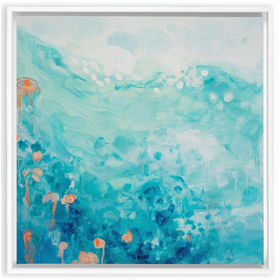# Expanded Research Document on Artwork Titles
This document offers **in-depth background** on why artwork titles matter, what strategies and real-world practices underpin effective titles, and which pitfalls to avoid. It is **not** an implementation guide; rather, it lays out the conceptual rationale and marketplace observations that support successful titling. Users or systems should combine this information with their own step-by-step instructions for actual title creation.
—
## 1. Why Artwork Titles Carry Weight
### 1.1 Viewer Engagement and Interpretation
– **A First Point of Entry**
A title can direct how viewers approach a piece. In contemporary galleries, visitors often glance at the title card before or during their initial view.
A well-chosen title sets an emotional or conceptual tone, prompting viewers to consider the piece’s deeper themes rather than dismissing it as random or abstract.
– **Guidance Without Over-Explanation**
A concise title can amplify an artwork’s mood or subject without spelling out its entire meaning. Many curators highlight how effective titles give “just enough” insight, so viewers feel invited to interpret, rather than forced into a narrow reading.
### 1.2 Marketability and Brand Identity
– **Memorable Handle**
In digital marketplaces, a memorable title is often the difference between an artwork catching a buyer’s eye or getting lost. Descriptive or evocative names tend to stick in a viewer’s mind more than “Untitled” or generic labels.
– **Professional Presentation**
Auction houses, galleries, and collectors all rely on titles for documentation and discussion. A thoughtful title can enhance perceived professionalism, showing that the artist approached every aspect of their work with care.
### 1.3 The Rise (and Fall) of “Untitled”
– Historically, many 20th-century abstract or conceptual artists left works untitled to avoid influencing interpretation. Well-known figures in expressionism or minimalism could still garner attention, despite lacking a formal name.
– For emerging artists, however, “Untitled” often alienates casual viewers and can reduce the artwork’s memorability. Contemporary buyer studies show that an “Untitled” piece by a lesser-known creator generally sees weaker engagement.
– In major auctions, top-selling untitled artworks typically come from already-renowned artists, highlighting that those famous names alone can offset the downsides of having no title.
—
## 2. Psychological and Emotional Dimensions
### 2.1 Influence on Perception and Monetary Value
– **Emotional Hooks**
Research suggests that titles evoking a story, emotion, or sense of mystery can increase both viewer satisfaction and final sale prices. Buyers often reference the artwork’s title when justifying their purchase or explaining its appeal.
– **Cognitive Framing**
Certain phrases can prime viewers to see aspects they might otherwise miss. A name hinting at tension or serenity makes them more attuned to subtle cues in color, line, or composition.
### 2.2 Balancing Openness and Clarity
– **Literal vs. Suggestive**
Works that are very literal (portraits, landscapes, historical scenes) may benefit from straightforward naming. However, overly literal titles can remove the viewer’s sense of discovery.
Highly abstract or conceptual pieces often need a subtle prompt to guide the viewer’s imagination—too vague, and the viewer may feel lost.
– **Room for Interpretation**
Many successful titles spark curiosity without resolving every question. Collectors appreciate titles that give them a story to share, yet still allow personal meaning.
—
## 3. Linguistic Approaches
### 3.1 Real-World Strategies and Examples
– **Referencing Inspiration or Place**
Artists and galleries sometimes note a location or an homage in parentheses. For example, a painter referencing historical influences might label a piece with “(After [Artist])” to acknowledge the conversation between works.
This practice can make a title more intriguing and inform buyers about context without an entire essay.
– **Indicating Series or Variations**
Reputable auctions often list works in a series with a consistent naming scheme (e.g., a sequence number, year, or color). The naming approach ensures each piece is unique while still showing they belong together.
### 3.2 Avoiding Overused Constructions
– **Cliché Phrases**
Terms like “Dance of,” “Echoes,” “Reflections,” or rhetorical questions are often flagged in restricted lists because AI systems and less-experienced artists over-rely on them. Overuse of these phrases tends to lower perceived originality.
– **Over-Poetic Language**
Stringing together multiple adjectives (e.g., “Eternally Whispering Azure Dreams”) can sound contrived. Real-world titles from major auctions are typically simpler, even if they hint at something deeper.
### 3.3 Tone, Style, and Audience
– **Matching the Artwork’s Character**
A whimsical, lively piece may warrant playful language, while a stark, minimalist composition may need a concise or austere title.
– **Cultural or Linguistic Flair**
Works referencing a specific region or tradition can incorporate relevant words or phrases—particularly effective if the artist has a personal link to that culture or location.
—
## 4. Structural and Practical Considerations
### 4.1 Title Length
– **Short Titles**
One to three words are favored if they convey enough meaning. This conciseness helps memory and display. Many iconic works are recognized by just one word.
– **Long Titles**
Sometimes contemporary art thrives on longer statements, especially if referencing an event or repeating a motif. For instance, works containing a phrase plus parenthetical info can become famous in part because of their distinctiveness. However, such length should serve a clear purpose (e.g., clarifying a repeated subject or referencing an anecdote).
### 4.2 Use of Parentheses, Subtitles, or Numeric Labels
– **Parentheses**
Widely used in galleries to denote a series name, location, homage, or date—especially for repeated motifs (e.g., multiple paintings of the same subject).
– **Numeric Labels**
Abstract expressionists and minimalists often do this to differentiate iterations of a motif (e.g., “Study #2,” “Variation IV”). Even if minimal, it signals continuity or progression in a body of work.
### 4.3 Relevance to Cataloging and Sales
– **Archival Convenience**
Auction houses and galleries prefer each piece to have a unique reference. Adding parentheticals or short clarifications helps keep track.
– **Marketing Utility**
A unique or story-rich title allows dealers and collectors to talk about the piece in an engaging way. “Untitled (Blue Series #3)” is more memorable than a plain “Untitled #3” when referencing a specific subject or palette.
—
## 5. Common Pitfalls and How to Avoid Them
### 5.1 Overly Generic Descriptions
– **Weak Impact**
Titles like “Landscape” or “Portrait” say little about a piece. These labels might suffice for well-known classical works (where the artist’s name is the real draw), but for contemporary art, they often appear underdeveloped.
– **Better Alternative**
Even minimal elaboration—like referencing the scene’s mood or location—makes it more appealing than an unadorned label.
### 5.2 Clichéd or Formulaic Phrases
– **“Dance,” “Reflections,” “Echoes,” and Similar**
These appear frequently in AI outputs and novice titles. Repetitive use signals a lack of originality. Many restricted lists specifically ban or limit them.
– **Empty Poetic Flourishes**
Stacking multiple flowery words can trigger skepticism from seasoned collectors, who see it as forced or unprofessional.
### 5.3 Rhetorical Questions
– **Confusion or Corniness**
Titles that ask “Where Does It End?” or “Who Am I?” often come across as clichéd attempts at mystery. Buyers can find them inauthentic.
– **Better Approach**
Suggest intrigue with a short phrase or reference, rather than direct interrogation.
### 5.4 Omitting Context for Series Work
– **Hard to Differentiate**
If you produce multiple versions of an abstract composition without distinct labeling, galleries struggle to identify each piece.
– **Simple Fix**
Parenthetical references (e.g., color or location) or a naming sequence helps unify the series while keeping each title unique.
—
## 6. Real-World Examples and Lessons
> **Note**: The following references are historical or factual illustrations, not templates to replicate verbatim. They demonstrate how known artists often employ or bend the above principles.
1. **Reference to Place or Event**
Certain modern artworks use a location in parentheses, e.g., a painting referencing a specific city block or district. This approach anchors the piece in a tangible context, making it easier for viewers to form connections.
2. **Numbered Series**
Well-known abstract painters sometimes give minimal titles, coupled with a numeric system (e.g., “Composition No. 10”). It doesn’t reveal much but provides enough difference between similarly themed pieces. That pattern is widely accepted among galleries.
3. **Parenthetical Explanations**
Works might add a quick note like “(After [Historical Artist])” to acknowledge the lineage or reinterpretation of classic motifs. This hints at an intertextual conversation that can intrigue collectors who appreciate art history.
4. **Warhol and Others with Lengthy Titles**
Some artists deliberately used longer, descriptive titles for shock or documentation. While famously recognized, these are exceptions that succeed because the art or artist is already in the spotlight. Emerging artists seldom benefit as strongly from “long statement” titles unless the context truly demands it.
—
## 7. Best Practices in Context
1. **Decide on Literal vs. Evocative**
– If the subject is distinctly recognizable (e.g., a well-known building or portrait), a near-literal title may work.
– If the piece is highly abstract, a suggestive title can help viewers latch onto a theme.
2. **Keep It Memorable**
– Use concise language that differentiates your work from similar pieces.
– If it’s part of a series, label it systematically but with some hint of variation (e.g., referencing color, location, or a guiding concept).
3. **Align with the Artwork’s Emotional Tone**
– A bright, whimsical painting might need a playful title, while a somber piece benefits from more subdued language.
– For conceptual art, the title might reference an idea or question the viewer can explore—without phrasing it as an actual question.
4. **Avoid “AI-Sounding” Stock Phrases**
– Over-reliance on words like “Ethereal,” “Harmony,” or “Symphony” in every third title signals formulaic repetition.
– Gallery owners often see this as a telltale sign the titles aren’t thoughtfully curated.
5. **Consider Cultural or Mythic Nuances**
– If the piece draws from myth, local folklore, or a literary source, referencing that can create depth.
– Avoid random foreign words if they have no link to the content or artist’s heritage.
—
## 8. Why Quality Titles Boost Engagement and Value
– **Emotional Link**
A compelling title can invite deeper empathy or fascination, turning casual browsers into engaged viewers who spend more time with the piece.
– **Storytelling Device**
Collectors often mention an artwork’s title when sharing it with friends or clients; a well-formed title becomes an immediate conversation starter.
– **Auction Data Insights**
Studies frequently find that works labeled with more creative or narrative-driven titles fetch higher average bids, especially for artists not yet established.
– **Long-Term Recognition**
Iconic titles like certain well-known pop art or post-war pieces remain in public memory. If the artwork gains traction, the title can become part of its brand.
—
## 9. Conclusion
Artwork titles serve as **vital connectors** between the viewer and the piece, shaping perception, sparking conversations, and influencing how easily buyers recall or value the work. While established artists can sometimes ignore these rules (e.g., using “Untitled”) and still sell due to their reputation, **most creators** benefit from choosing titles thoughtfully, balancing clarity and openness. By referencing location, mood, or subtle hints of narrative—without slipping into clichés—an artist can significantly elevate how audiences engage with the art.
This document **focuses on conceptual foundations** and insights drawn from real-world examples, auction data, and gallery practices, rather than prescribing implementation steps. Combine this knowledge with precise instructions or workflows to generate final artwork titles that feel **authentic, memorable, and market-friendly**.


